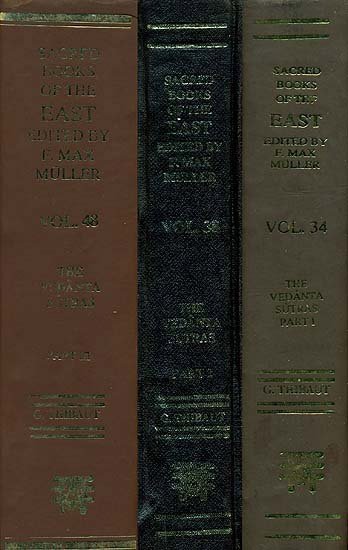Brahma Sutras (Ramanuja)
by George Thibaut | 1904 | 275,953 words | ISBN-10: 8120801350 | ISBN-13: 9788120801356
The English translation of the Brahma Sutras (also, Vedanta Sutras) with commentary by Ramanuja (known as the Sri Bhasya). The Brahmasutra expounds the essential philosophy of the Upanishads which, primarily revolving around the knowledge of Brahman and Atman, represents the foundation of Vedanta. Ramanjua’s interpretation of these sutras from a V...
Sutra 2.2.42
42. Or, if they are of the nature of that which is knowledge and so on, there is no contradiction to that (i.e. the Bhāgavata doctrine).
The 'or' sets aside the view previously maintained. By 'that which is knowledge and so on'[1] we have to understand the highest Brahman. If Saṅkarshaṇa, Pradyumna, and Aniruddha are of the nature of the highest Brahman, then truly there can be no objection to a body of doctrine which sets forth this relation. The criticism that the Bhāgavatas teach an inadmissible origination of the individual soul, is made by people who do not understand that system. What it teaches is that the highest Brahman, there called Vāsudeva, from kindness to those devoted to it, voluntarily abides in a fourfold form, so as to render itself accessible to its devotees. Thus it is said in the Paushkara-saṃhitā, 'That which enjoins that Brahmaṇas have to worship, under its proper names, the fourfold nature of the Self; that is the authoritative doctrine.' That this worship of that which is of a fourfold nature means worship of the highest Brahman, called Vāsudeva, is declared in the Sātvata-saṃhitā, 'This is the supreme śāstra, the great Brahmopanishad, which imparts true discrimination to Brahmawas worshipping the real Brahman under the name of Vāsudeva.' That highest Brahman, called Vāsudeva, having for its body the complete aggregate of the six qualities, divides itself in so far as it is either the 'Subtle' (sūkshma), or 'division' (vyūha), or 'manifestation' (vibhava), and is attained in its fulness by the devotees who, according to their qualifications, do worship to it by means of works guided by knowledge. 'From the worship of the vibhava-aspect one attains to the vyūha, and from the worship of the vyūha one attains to the "Subtile" called Vāsudeva, i.e. the highest Brahman'—such is their doctrine. By the 'vibhava' we have to understand the aggregate of beings, such as Rama, Kṛshna, etc., in whom the highest Being becomes manifest; by the 'vyūha' the fourfold arrangement or division of the highest Reality, as Vāsudeva, Saṅkarshaṇa, Pradyumna, and Aniruddha; by the 'Subtle' the highest Brahman itself, in so far as it has for its body the mere aggregate of the six qualities—as which it is called 'Vāsudeva.' Compare on this point the Paushkara, 'That body of doctrine through which, by means of works based on knowledge, one fully attains to the imperishable highest Brahman, called Vāsudeva,' and so on, Saṅkarshaṇa, Pradyumna, and Aniruddha are thus mere bodily forms which the highest Brahman voluntarily assumes. Scripture already declares, 'Not born he is born in many ways,' and it is this birth—consisting in the voluntary assumption of bodily form, due to tenderness towards its devotees—which the Bhāgavata system teaches; hence there lies no valid objection to the authoritativeness of that system. And as Saṅkarshaṇa. Pradyumna, and Aniruddha are the beings ruling over the individual souls, internal organs and organs of egoity, there can be no objection to their being themselves denoted by those latter terms, viz. individual soul, and so on. The case is analogous to that of Brahman being designated, in some texts, by terms such as ether, breath, and the like.
Footnotes and references:
[1]:
Or 'by that which is knowledge and cause.'
